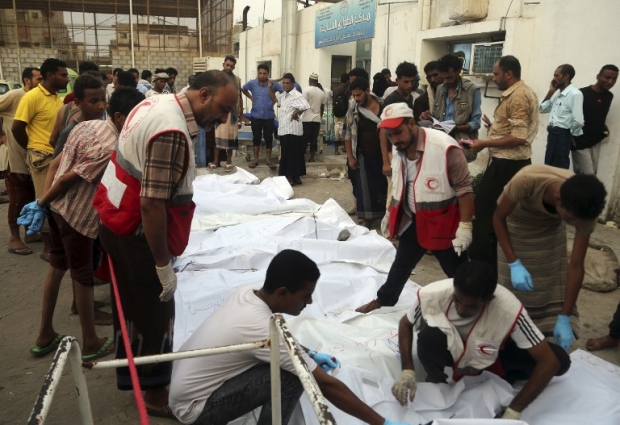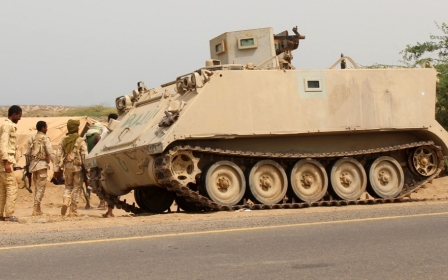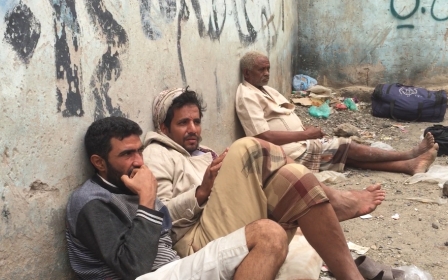Who hit Hodeidah? Question marks surround culprit of deadly Yemen attack
SANAA – Five days after an attack in Hodeidah in Yemen that left scores dead and was immediately blamed on Saudi-led coalition air strikes, the identity of the warring party responsible for the attack is still unknown.
As new evidence has been unearthed, question marks loom over whether the attack was carried out by warplanes.
On Thursday, a fishing port, market and hospital entrance in the Red Sea city were bombarded in a surprise attack that killed 60 and left more than 100 wounded, according to a Hodeidah health official.
Forces loyal to Yemeni President Abd Rabbuh Mansour Hadi, backed by coalition airpower, are currently massed on Hodeidah’s outskirts.
Pro-government forces are determined to seize the strategic port city from the Houthi rebels, though a full-blown battle has been averted so far because of United Nations mediation efforts. Pro-government forces also wish to regroup before staging an assault.
There have been occasional flare-ups since the ceasefire came into effect. On 27 July the coalition launched a string of heavy strikes on Houthi positions. Thursday’s assault initially appeared to be more of the same.
Witness Alaa Thabet told Middle East Eye he was convinced the attack was carried out by coalition warplanes.
"While I was coming back to my house, I heard a warplane hover," he said.
"Then I heard an air strike target the fish market and the buzzing of the warplane was clearer after the attack."
Photographs of what appear to be mortar bomb shells found at the blast sites have emerged, however, adding to speculation that the coalition’s air force was not behind the attack.
Images released by the Houthi-run al-Masirah TV channel and circulated by pro-government activists also seemed to show destruction more consistent with a mortar attack than an air strike.
"Pro-Hadi media cannot work in Hodeidah and we got the evidence from videos were taken by al-Masirah TV channel,” Jamal al-Zuraiqi, a pro-government social activist in the southwestern city of Taiz, told MEE.
"The videos did not show any craters in the ground and the [al-Masirah] reporter said there was more than one explosion. All of us know that air strikes leave craters in the ground, so this cannot be an air strike."
Accusations and counter-accusations
The coalition itself was quick to deny it was behind the attack.
"[The] coalition did not carry out any operations in Hodeidah today," its spokesman, Colonel Turki al-Malki, told Al-Arabiya television.
"The Houthi militia are behind the killing of civilians in Hodeidah," he said.
Coalition denials of responsibility for deadly air strikes have in the past been proven to be false, for instance after an attack on a wedding party in 2016 that killed around 70.
A source in Hodeidah’s health office insisted coalition air strikes were behind the deaths at the hospital’s entrance.
He said there was “only one big explosion that killed dozens of people”, adding that a single mortar bomb could not leave more than 100 people dead or wounded.
“Usually they absorb the anger of Yemenis by denying killing civilians. We demand an international investigation [into] the aggressors’ [coalition] targeting of civilians in Hodeidah," Mohammed al-Dailami, a pro-Houthi political analyst, told MEE.
"The aggressors and their mercenaries do not shy away from denying something that all people are sure about, but if there is an independent investigation, that will expose them."
Why the Houthis would attack civilians in a city they are defending is not clear.
'The Houthis exploit the hovering of Saudi-led warplanes to target civilians, to trick the world into thinking the coalition targets civilians'
- Ali al-Makosh, pro-government fighter
One reason posited by supporters of the government is the rebels may be trying to discredit the coalition by staging an attack while warplanes are in close proximity.
"The Houthis exploit the hovering of Saudi-led warplanes to target civilians, to trick the world into thinking the coalition targets civilians," Ali al-Makosh, a pro-government fighter in Marib province, told MEE.
The pro-government Amaliqa militia has mortars located five kilometres from the blast sites, but analysts and fighters believe the militia prefers to rely on air strikes.
Media outlets run by both sides have given conflicting reports about who holds various parts of the city.
New MEE newsletter: Jerusalem Dispatch
Sign up to get the latest insights and analysis on Israel-Palestine, alongside Turkey Unpacked and other MEE newsletters
Middle East Eye delivers independent and unrivalled coverage and analysis of the Middle East, North Africa and beyond. To learn more about republishing this content and the associated fees, please fill out this form. More about MEE can be found here.





